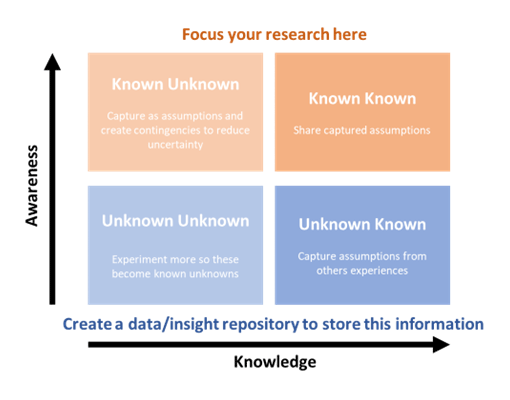13th November 2023

Want to take steps to better deal with the volatility in your contact centre? Keith Stapleton explains all.

To understand volatility, you need to understand its cause. Traditionally in call centres, we consider ourselves to be “data rich”; however, we are often “insight poor”.
By this I mean we have limited or no means to identify the cause of volatility, other than to rely on individuals’ memories or limited record keeping.
Cause analysis is a crucial part of understanding and should be core to reporting, as well as forecasting, so I recommend that you review how well you capture, retain, and use this information.
Unfortunately, unforeseen events will occur, volatility at its most difficult. As mentioned, we should expect some form of volatility at all times. To quote Donald Rumsfeld:
“There are known knowns. These are things we know that we know. There are known unknowns. That is to say, there are things that we know we don’t know. But there are also unknown unknowns. There are things we don’t know we don’t know.”
The known/unknowns table is easy to create (see below). My advice here is to at least try to place your causes of volatility into each section, then you can better understand their impact if unchecked or addressed and take appropriate action.

Volatility is more readily associated and applied to demand forecasting and monitoring.
We have always aimed for our forecasts to be within a given volume tolerance. If you only look at the total demand, you’re at risk of not identifying the volatility underneath that influences the staff schedules – when different skills are in play.
It is often the case that aggregated volumes present a very different outlook to the sums within them.
The same forecast is used to schedule staff to meet the demand as best possible. The “fit” of the schedules to the forecast should be assessed to understand the impact of volatility in both forecast and staff availability.
Staff availability is very volatile, both when schedules are created and by the time they are worked. Absence is an obvious contributor to the availability of staff, but so are the other activities that take them away from meeting customer demands.
It’s common to focus on the big numbers first, but when you total the other reasons, they can be higher, so it is as important to plan and schedule for staff unavailability as it is availability.
Extreme volatility (boom or bust) is not conducive to strong employee engagement and wellbeing.
Care is needed to ensure staff welfare is maintained through delivering a reasonably balanced workload for people wherever possible.
Extreme volatility (boom or bust) is not conducive to strong employee engagement and wellbeing, and is more likely to drive burnout, boredom, absenteeism, attrition, and underperformance.
Compare the resource you had available against that expected (scheduled) and the reasons for differences.
Remember, it’s not always possible to meet all peaks in demand, so the rationale behind any decisions made is as insightful as the numbers themselves.
If you are expecting a 10% swing in demand volumes, do you have similar flexibility in your workforce? If you do, you should be able to schedule or manage them effectively without the need to follow a “playbook” or take frequent extraordinary measures.
When you do not, I’d expect to undertake a review of schedules and to explore demand-smoothing techniques. This is where the resource planning team can support the operation before an event occurs.
Volatility often presents similar challenges and, once better understood, solutions can be predetermined. This should ensure more consistent outcomes, as well as better understanding the impact on staff.
This is often referred to as creating and using a “playbook”. Creating and using such a document requires governance around its ownership. Recognizing the playbook as a means to make decisions is an important part of its success.
A word of caution, if needed, is not to follow the playbook if the circumstances do not match those documented, or if the operational management at the time sees a better way. If this occurs, don’t forget to consider updating your playbook. Do not let this valuable learning slip through your fingers.
So far, I’ve looked at how to identify and mitigate volatility when it occurs. There are ways to reduce it, however, and whilst they may not be entirely within your hands to implement, it is important to recognize them and their impact.
Demand smoothing may feel out of your hands, but when you select the data to create forecasts, schedules, and predictions, ensure that you have reviewed it and the circumstances surrounding it – so you can remove any “outliers”.
When an event has occurred, are you confident it will happen again, and should that data be included again? Luckily, most WFM systems help identify such occurrences, but rarely do they hold the details of why. The graph below is a very simple means to identify an outlier:

Matching resources to demand is the same. Focusing on one without the other presents an incomplete picture. Consider what “being busy” really means to different people.
Changes to the way your organization serves its customers are commonplace. AI and automation are playing a part in changing the demand volumes, and therefore the impact of volatility.
It would be fair to assume most customer interactions are more complex than 10 years ago, when they were more transactional in nature.
Complexity adds to the impact of volatility, so it’s beneficial for the planning team to be party to any change programmes and not just presented with their outcomes to deal with.
To conclude, volatility is inevitable, and some of it is understood whilst some is not, so its impact varies greatly.
It is unwise to leave dealing with it to chance, but neither is it wise to believe you can have a solution ready for all circumstances. You can, however, take steps to alleviate both the impact of and the effort to deal with volatility.
Written by: Keith Stapleton, Director at Select Planning Ltd, and Associate Consultant at The Forum
If you are looking for more articles and advice on workforce planning, read these articles next:
Reviewed by: Megan Jones